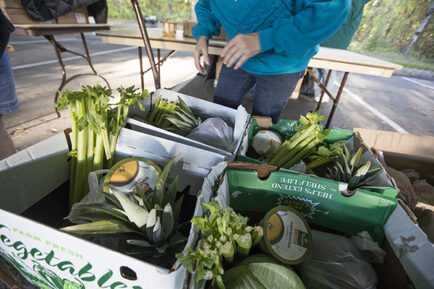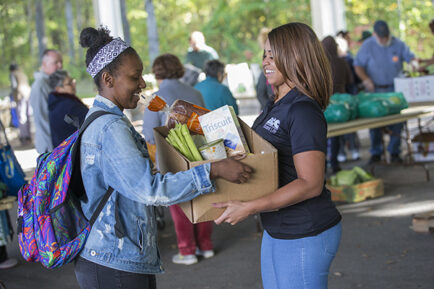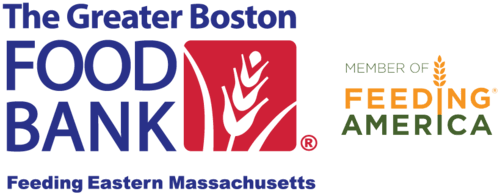Hunger on Campus: Who are the hungry?
Part Two: Hunger on Campus
Who are the hungry? Who are today’s students?
We might think of college students as young people with their high school diploma marching straight on to campus for a college degree and a bright future, supported by parents and helpful federal grants, loans with small interest rates, or generous scholarships.
But the demographic profile of who is a student has changed.
An advanced degree has become a necessary ticket to a successful career, and the good news is that more low-income students are now enrolled. But almost 50% of today’s students arrive on campus independent from their parents and with no family financial cushion. Many are older. Some are career changers. Nationally, the average college student is now 26 years old, and as many as 22% arrive with families of their own to support – we know this thanks to a report by the Government Accountability Office (GAO) released in December 2018. Because of the pandemic and growing needs, that number has likely increased. Even with loans, scholarships and grants, work-study jobs, internships, and after-school jobs––the excessive cost of tuition, books, and miscellaneous fees means that basic human needs like food and housing often go unmet.

Kathleen O’Neill, the Director of the Single Stop program at Bunker Hill Community College, works on getting resources to help students stay in school. “Our students are extremely motivated and determined to get their degree, to get their certificate. The average age of our students is 26 – and many have children and other dependents. But when we ask them, ‘Have you eaten today?’ The number who say ‘no’ is astounding.”
And it is not just undergraduate students who are food insecure.
At Brandeis University, home to many international graduate students, Steve Weglinski, who launched the food pantry on campus, estimates that over 50% of Brandeis’ graduate students come with funds that can cover tuition but woefully short of money for food and housing. “They are arriving totally unprepared for the cost of living in the Boston area,” he says.
As these statistics started to percolate, colleges began to respond. Ad-hoc and volunteer-staffed food pantries began to appear on campuses, often in makeshift spaces where students could grab shelf-stable groceries to make it through the week. Some, like the food program at Bristol Community College, have drive-up opportunities, where a member of the community registers ahead of time with a specific time slot and have their items placed in their cars. Some campuses have partnered with GBFB to have on-campus mobile markets. Others are all about grab-and-go. Some are open to staff and members of the wider community.
But one thing all have in common: No questions asked. No stigma. No shame. Simply need.

These food pantries rely on the support and partnership of The Greater Boston Food Bank, which delivers pallets of fresh and healthy food weekly. The partnership with GBFB is crucial, streamlining the order and delivery process and allowing campus food pantries to provide a variety of fresh food and produce, as well as shelf stable favorites like peanut butter, pasta, and spaghetti sauce.
A refrain heard from all the campus personnel we spoke with is that they are so grateful for the support and assistance of the GBFB team. Kathleen shares, “Welcoming is the word I use. Everyone associated with GBFB, from the people who answer the phone to delivery truck drivers communicate that they are compassionate and here to help. It gives us hope.”
Voices from Massachusetts Campuses:
Emma Montague is the Director of Student and Family Engagement at Bristol Community College (BCC). As a commuter school in a stressed community, the BCC pantry is also open to staff, alumni, and residents, though many recipients are students. “It’s hard to separate the students with hunger needs from their wider community which has widespread food insecurity,” she says.
The food assistance program at BCC has been operating for eight years, and never takes a break, Emma shares: “We never stop. Not for summer or holidays.”
She is the point person for ordering and organizing food for the wider and campus communities of Fall River, Taunton, New Bedford, and Attleboro, distributing 350-400 orders each week. Each person gets two tote bags that contain around 40 pounds of groceries, a combination of fresh, frozen and shelf-stable staples.
Students must register for food by Tuesday, Emma places her orders with GBFB, deliveries come in on Thursdays, and volunteers unload the pallets and pack the bags for Friday pick-ups – every single week. Cars begin to line up by 8:30 a.m. on pick-up days.
Before COVID, people who needed food could come in and effectively “shop” for what they wanted. But in the wake of the pandemic, the distribution is exclusively drive-through.
Emma continues, “We couldn’t do it without The Greater Boston Food Bank. There is never a problem or a delay. Never a hiccup. We place our order, and the food arrives like clockwork.”
Rachel Frank, Salem State’s Student Life Case Manager, is focused on currently enrolled students whether commuters or campus residents. The school has about equal numbers of commuters from the North Shore and residential students. Like BCC, there are no questions asked, but students do need to have a current ID, though she says, “No one checks.”
Grab and go, shelf-stable groceries are always available, and on Wednesdays the Salem Food Pantry sets up a morning pop-up market with fresh produce.
Rachel explains that the on-campus dining halls have very limited hours, “And many if not most of our students can’t get to the dining hall as they juggle the demands of class schedules and part-time jobs. They don’t have access to kitchens, or resources to buy expensive off-campus food.”
There is no school budget for the school food pantry, so Salem State relies on donations for the funds to purchase food. She has put together a novel approach to make sure the pantry stocks the food that students want and need: Amazon. She explains, “We have a sort of ‘wish list’ on Amazon so that donors can go right the site and purchase food that gets delivered to the Salem State Food Pantry. We get a lot of fresh food from The Greater Boston Food Bank, and the other convenience items come from our donors through Amazon.”
Arnie’s Cupboard at University of Massachusetts-Dartmouth operates in a different model, and benefits from a broader base of financial support – much of it from the surrounding South Coast community.
Deacon Frank Lucca, the campus minister at UMass Dartmouth and Coordinator for Religious and Spiritual Life, remembers when it began: “Five or six years ago, two young women who were Endeavor Scholars, which is a UMass scholarship program for people looking to make a change in the world around them through service, started talking about food insecurity on our campus.” He continues, “At first, people did not understand…. How could college students be hungry?”
Deacon Lucca explains that the two students put together a small pantry in a 300-square foot space, just off the auditorium, establishing Arnie’s Cupboard on the UMass Dartmouth campus. When they graduated, the administration tapped Lucca to run with it. At first, like many – he questioned the need, but soon learned that it is a national issue at both public and private universities. Colleges like Boston College and Notre Dame have food pantries, too.
“We discovered that around 28% of our own students had experienced food insecurity, and that between 1,500-2,000 of our students were in need.” Deacon Lucca explains, “We have over 125 students who volunteer to work in the food pantry. I think that’s a fairly good sign that students understand that some classmates are hungry, and are struggling to find enough to eat.”
After years of operating out of a cramped space with no access to refrigeration or air-conditioning, this month Arnie’s Cupboard is moving into a newly renovated space, (“State of the Art!” says Deacon Lucca), with refrigeration and freezers. This capacity means they can begin to offer fresh produce and proteins like chicken, turkey, and hamburger, as well as more dry goods. As a GBFB partner agency, Arnie’s Cupboard receives around 2,000 pounds of food a month – and now, more fresh food than ever.
In Conclusion
Many local schools are mitigating the problem of food insecurity on campus – but not all, and not enough. Campus hunger will only continue to grow, and we need to act now.
The Hunger-Free Campus Coalition will help college campuses support the hungry not only across our Eastern Massachusetts community but the entire state.
We are proud of GBFB’s stewardship. If this story moves you, ask your legislator to support the bill. And think about how you can be part of the solution – the next generation of leaders on our college campuses needs you.
- Check out Part 1 of Hunger on Campus
- Learn more about the Hunger-Free Campus Coalition
- Visit the coalition’s Take Action page to learn how you can take steps to become part of the solution
- Read Mariela’s story, a graduate student receiving fresh food from Brandeis University’s FRESH program, in partnership with GBFB partner agency Healthy Waltham.
